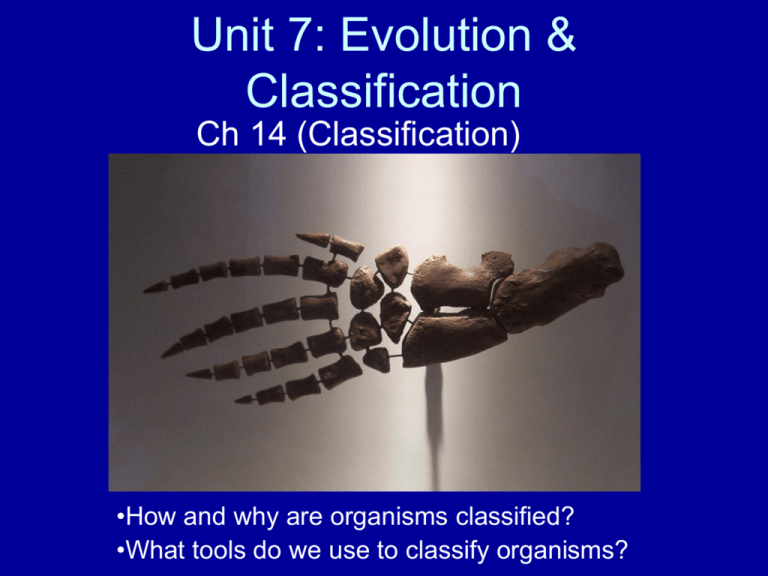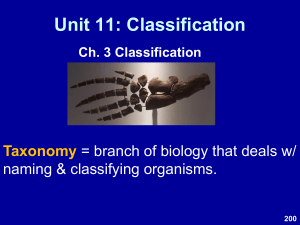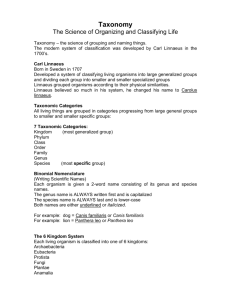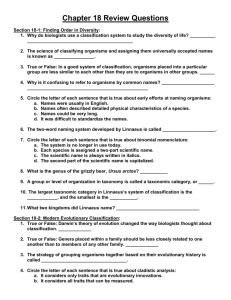Classification - Mrs. GM Biology 200
advertisement

Unit 7: Evolution & Classification Ch 14 (Classification) •How and why are organisms classified? •What tools do we use to classify organisms? Classification • Taxonomy = branch of biology that deals w/ naming & classifying organisms. • Why do we classify??? Early Classification • First classification system – Aristotle (Greek philosopher) • >2000 years ago divided organisms into 2 groups – 1. Plants » classified by type of stem – 2. Animals » divided by environment (land, water, or air) According to Aristotle which of these 3 animals would be classified more closely? How Do We Classify? • Based on work of Carolus Linnaeus –“Father of Modern Taxonomy” How Do We Classify? • Current system reflects relationships based on phylogeny (evolutionary ancestry) – Uses homologies to group species into larger, more generalized categories • According to this who are humans closely related to? phylogenetic tree most Linnaeus’ System • Binomial nomenclature: Two name system that is unique to every type of organism Linnaeus’ System – Names are Italicized or underlined – written as Genus species • Genus = 1st name, capitalized • species = 2nd name, lower case & descriptive Linnaeus’ System • All names are in Latin • Why not common names? Examples of names Common name 1. Humans 2. Housefly 3. White Oak tree 4. Red Oak tree Genus & species 1. Homo sapiens 2. Musca domesticus 3. Quercus alba 4. Quercus rubra Levels of Classification • • • • • • • • Did King Phillip Come Over From Germany Sunday? Domain Kingdom Phylum Class Order Family Genus species Domain Eukaryota Where would Domain belong in this diagram? Levels of Classification • What is the relationship among the levels? – More closely related share more levels – From Domain down each level has a new set of criteria that must be shared DOMAIN Eukaryota Once an organism shares a more specific taxon it MUST share the more unifying taxa How many levels of classification do we share with dolphins? What is a species? • Group of organisms capable of mating with one another in nature to produce fertile offspring The 3 Domains 3 domains Archaea Eubacteria Eukaryota Oldest prokaryotes that evolved from Archaea (no nucleus) Eukaryotes (cells with a nucleus) prokaryotes (no nucleus) Kingdom Monera (older, less complex bacteria) Kingdom Monera (more complex, modern bacteria) Kingdoms Plantae, Animalia, Fungi, Protista Domain: Archaea • Prokaryotes – Older, less complex group of bacteria • live in extreme environments – hydrothermal vents, salty or acidic environments Domain: Eubacteria • Prokaryotic – Modern, more complex bacteria • Evolved from Archaea – Most common & very diverse, heterotrophic or autotrophic, free-living or pathogenic cyanobacteria Staphylococcus If Using the 5 Kingdom System Instead of the 3 Domain System • Eubacteria + Archaea Domains together make up 1 of the 5 Kingdoms Monera Domain: Eukaryota • All are eukaryotic –have a nucleus • 4 of the 5 kingdoms –1. Protista –2. Fungi –3. Plantae –4. Animalia Domain: Eukaryota 1. Kingdom Protista: mostly unicellular organisms that are plant-like, animal-like, or fungus-like Amoeba Euglena Paramecium Diatoms Domain: Eukaryota 2. Kingdom Fungi: all types of fungus (mushrooms & molds) – Multicellular heterotrophs with cell walls of chitin ( yeast – unicellular) • Digest food outside the organism & then absorb nutrients Domain: Eukaryota 3. Kingdom Plantae: Multicellular autotrophs with cells walls of cellulose – Land-based plants, trees, grasses, moss, and shrubs • photosynthetic Domain: Eukaryota 4. Kingdom Animalia: multicellular heterotrophs without cell walls. –divided into invertebrates and ………….. ………. vertebrates







